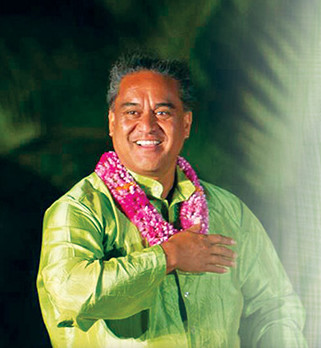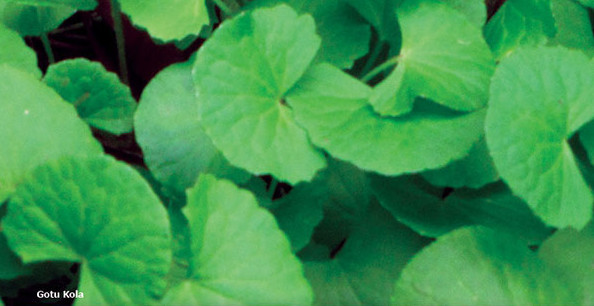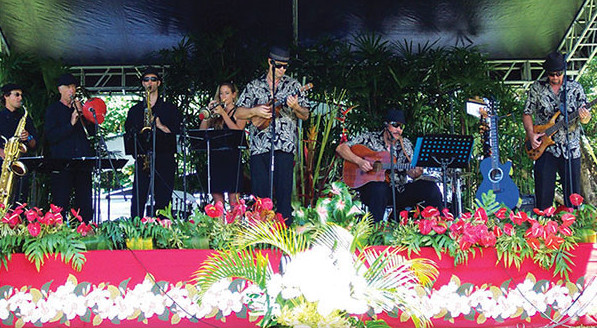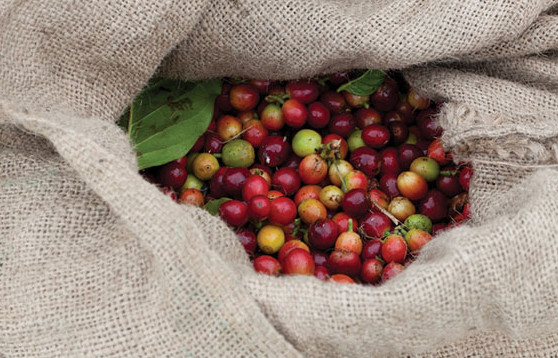
Lighting the Path: Kumu Keala Ching Liberally Shares His Passion for Hawaiian Culture
 By Karen Valentine
By Karen Valentine
A gentle, humble, and graceful man commands a presence on stage or facing a group of students—rapt and listening intently. A kumu hula (teacher of hula), kumu ‘ōlelo (… Hawaiian language), kumu oli (… chant), practitioner of ho‘oponopono (peacemaking) and lomilomi (Hawaiian massage). Perhaps most evident to readers of Ke Ola magazine, composer, Kumu Keala Ching speaks softly and carries huge mana. Some say he calmed the ocean waters with his chants during an annual New Year’s ʻhi‘uwai (water cleansing ceremony).
Who is this multi-faceted and perhaps enigmatic man?
Kumu Keala Ching seems to be most comfortable around the keiki (children) who parade proudly, if somewhat disorderly, across the stage during the annual hō‘ike performance of hula students of Nā Wai Iwi Ola, the educational foundation and hula hālau that he heads. In colorful hula dress and bright green lei almost too large for their bodies, they grin. Parents and grandparents in the audience beam. The kumu himself has a childlike twinkle in his eye as he leads them through their carefully practiced dances.
Kumu Keala, on another day, will just as readily lead a group of adults through the song and movements of “The Hokey-Pokey,” leaving them smiling and laughing at themselves. A graduate of the University of Hawai‘i in the field of early childhood education, and currently pursuing his master’s degree in the same field, Keala says his intent is to awaken the inner child in all of his students—of all ages. “My belief is that each one of us has a child within us. Studying early childhood education helps me connect with this inner child.”
Kumu Keala comes from humble beginnings, having been raised in Nānākuli on the Wai‘anae Coast of O‘ahu, a place that, even in ancient times, was known as a dry and poverty-stricken area. It is heavily populated with native Hawaiians who struggle within the environmental conditions and the lingering effects of the decimation of the race.
While growing up, Kumu Keala was somewhat uncertain how to synchronize his Hawaiian-ness with the American culture in which he was living. The story of how he got his name may help explain how he has overcome and even capitalized on this dichotomy.
Atypical of someone with 75 percent native Hawaiian blood, Kumu Keala Ching has only three names: Michael Keala Ching. All his friends had a string of Hawaiian names. His mother gave him the name Michael, and his maternal grandmother provided the name Keala.
“All my life, my grandmother has been the one who guided me, took care of me, watched over me. One time I asked her to elongate my Hawaiian name, and she refused, saying that, when you get older, you will understand your name. It is just Keala.
“Keala is a very significant name to me,” he says, “because it means ‘the path.’ I honor both names, because both names are so significant. Archangel Michael is said to be in charge of protection, courage, strength, truth, and integrity, offering direction on our paths. You have Archangel Michael and you have Keala—both mean ‘the path.’ Hawaiians know there is a purpose to our names; names are not just given. Today, I understand both of my names, because they have been the guide to what I am doing.”
Opportunity came to young Kumu Keala and he was able to attend Saint Louis School, a prestigious private school for boys, taking the bus every day across the mountain range. Friends from school introduced him to hula and he eventually joined the hālau of Darrell Ihi‘ihilauakea Lupenui, the Men of Waimapuna. Still his quest to know his Hawaiian-ness was unfulfilled. After graduation, he attended Leeward Community College.
“I decided, for myself, to study Hawaiian language, knowing that there was a part of me that felt incomplete, yet feeling very complete. I knew I was Hawaiian, and I didn’t really know what the specialties of being a Hawaiian were all about. I really didn’t speak the language when I was growing up, yet I knew how beautiful the language was. When I went to school to gain the language, it was like a waterfall. Everything just started to overflow. The language, the dancing, the chanting, the composition, the ho‘oponopono—everything that I do now is because I decided to go and learn,” Kumu Keala explained. “It comes very naturally. It’s almost like I’m communicating with the spirit world, that’s how wonderful it is!”
His first attempt to compose in Hawaiian language, and speak his composition, came when his family asked him to give a Hawaiian pule (prayer), at Thanksgiving dinner. The Hawaiian chant is a prayer that asks the spirit to come into us and hear our words. Many Hawaiian chants use the word kūpuna to refer to ancestors or the spirits of a place who have passed on yet remain as guardians.
The Word
As in all spiritual beliefs, the word has power, and we must carefully choose our words, says Keala.
I ka ‘ōlelo no ke ola, i ka ‘ōlelo no ka make.
In the word there is life, in the word there is death.
“This ‘ōlelo no‘eau, or saying, comes from the fact that, in ancient Hawai‘i, a kahuna ‘anā‘anā could pray someone to death or counter another’s death prayer. It says that words can either be a source for healing or destroying, and so we need to be careful with our words,” says Kumu Keala. “If you speak the truth, you will continue to live. If you don’t speak the truth,
you will fail. Choosing wise words will keep you alive.”
The Way
There is the word, and there is the way—the path: ke ala. In most chants or compositions written by Kumu Keala Ching, he incorporates the phrase, ke ala, in its many meanings and also as a kind of signature. Ironically, he lives in a home he purchased in 1999 on Hawaiian Homelands in the ahupua‘a or land division of Kealakehe. Keala-kehe translates to the “path of the spirit.”
As a youth, Keala Ching had three goals. One was to dance in the Merrie Monarch Festival. One was to paddle the grueling 26-mile Moloka‘i-to-O‘ahu canoe race. One was to own his own home. He has now accomplished all three.
In 1983, Keala completed the nine-man Moloka‘i-to-O‘ahu race as part of the team of Leeward Kai Canoe Club, and finished among the leaders.
In 1986, at the age of 20, Keala danced on the Merrie Monarch stage with the Men of Waimapuna, winning first place in both the Kahiko Kane and ‘Auana divisions. To this day, he believes it was the highest scoring kahiko performance in the history
of the competition.
“Hawaiian Homelands,” says Kumu Keala, “is one of the greatest gifts left to us Hawaiians by Prince Jonah Kūhiō Kalaniana‘ole.” The Hawaiian Homes Commission Act of 1921 set aside 200,000 acres of land to enable and assist native Hawaiians to obtain ownership of their ancestral lands.
Kumu Keala was fortunate to have the opportunity to purchase his house on an ahupua‘a—Kealakehe—that was once the home of two great-great grandfathers on his mother’s side.
“I know this is my home,” he affirms.
Upon coming to Hawai‘i Island, he taught at a language immersion school in Waimea. At the same time, he began his own adult classes in Hawaiian language, then hula in Kailua-Kona.
Following his life’s path with certainty of purpose, in 2000 he founded Nā Wai Iwi Ola, which has grown into a foundation that supports the teaching of Hawaiian culture in a broad sense. The name means “The Waters of Ancestral Knowledge.”
“The reason we started our foundation was to bring together the elders and the children, and it was really to take the children on a journey outdoors, knowing that learning was best there. We were invited first by elders of the Keahuolu area (in North Kona) and the Queen Lili‘uokalani Children’s Center. The knowledge came from the elders of that ahupua‘a. We taught the children the protocol of the historical use of the area, which focused on the fishing, fishponds, how to take care of the land, and how to understand the ocean and its currents.”
Subsequently they were invited to Honomolino and Miloli‘i to learn the methods of catching ‘ōpelu in the open ocean, to Waipi‘o Valley to work with kalo (taro), lo‘i (ponds), and to spend a weekend with the crew of the Makali‘i, Hawai‘i Island’s voyaging canoe.
The pathway of learning then extended across the seas to Europe and Japan, where Kumu Keala has established connections with hula hālau in Switzerland and Japan to teach their students Hawaiian culture, values, and arts.
“All this effort is for the foundation. It is helping our children walk in the footsteps of our king, David Kalākaua, who traveled around the world and was received royally by other countries. They were surprised and impressed with his compassion for people and his desire to form treaties of friendship. It is such a joy to see the world through the eyes of our children,” says Kumu Keala.
The keiki who travel with Nā Wai Iwi Ola have first completed seven or eight years of study with the school. They learn hula, the language, and oli before they can go out as ambassadors for Hawai‘i.
A graceful and accomplished dancer, Kumu Keala has continued his own study of hula under his current kumu, Frank Kawaikapuokalani Hewett, and graduated in the ‘ūniki rites of a kumu hula. He established his own hula hālau, Ka Pā Hula Nā Wai Iwi Ola at Kealakehe. He has a kūpuna group, Nā Wai Puna o Kona, and periodically teaches Hawaiian language classes.
Kumu Keala feels that it is important to keep the language alive through composing meaningful chants and songs that are relevant in contemporary times.
Many traditional Hawaiian chants have been written down and placed into collections. After a century or so, it is difficult to know just what the intent of the composer was. In the oral tradition of Hawaiians, there were certain ones entrusted with knowing the chants and passing them down. After the oral tradition faded, as the missionaries taught Hawaiians to read and write, the compositions were then recorded on paper.
“Do we know the true meaning of these chants today?” asks Kumu Keala. “No. In the old times, they wrote for situations that happened then. Many of these chants were put into collections by some individual—did they know exactly what the composer had in mind? Probably not. My desire is to create songs, chants, and stories that depict the moment for which it is written. I encourage others to use the chants to continue to hold the light inside themselves.”
What is Kumu Keala’s goal for teaching Hawaiian culture?
“For me, it’s to help everyone—non-native and native—to feel comfortable in their own skin, truly understanding where they are, where they have come from, and how to integrate all of that together. We teach these values that we all talk about: the aloha spirit, the lōkahi spirit, the pono spirit. My goal is to help you understand that certain things in these values are truly what we all can live by, no matter what culture you come from. One of the most important values is aloha. It is compassion. Well, Europeans have compassion, Japanese have compassion, Polynesians have compassion, even if they don’t use the word aloha.
“Every culture has these values. If you understand them, then you can feel comfortable in your own skin, and not always think that the grass is greener on the other side. If we are to understand these words that have been left to us, as Hawaiians, then it really helps us to understand who we are in our own skin. Many of the teachers of the Hawaiian culture feel that it needs to go through some purification: teaching only Hawaiians. That’s not my view, hence I can’t speak for those that feel that way.”
Kumu Keala Ching is generous with sharing the knowledge entrusted to him. He feels it is the only way—ke ala—that will keep the Hawaiian culture alive, vital, and spreading aloha all around the world. As in oral tradition, he entrusts with his students the responsibilities of holding the teaching and responsibly sharing it with others—carrying the torch and passing it along to keep the pathways alight. ❖
Contact Kumu Keala Ching: nawaiiwiola.org
Contact writer Karen Valentine: karenvalentine808@gmail.com
Online Extra—Watch the Men of Waimapuna at 1986 Merrie Monarch
[youtube]http://www.youtube.com/watch?v=TUPn4wNZyUA[/youtube]


